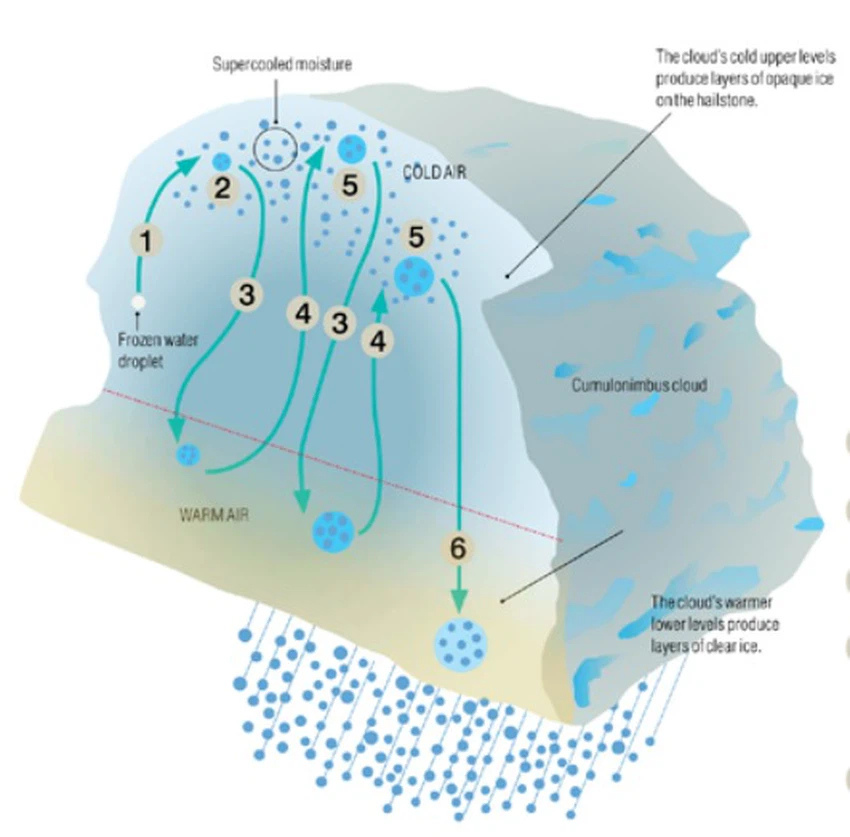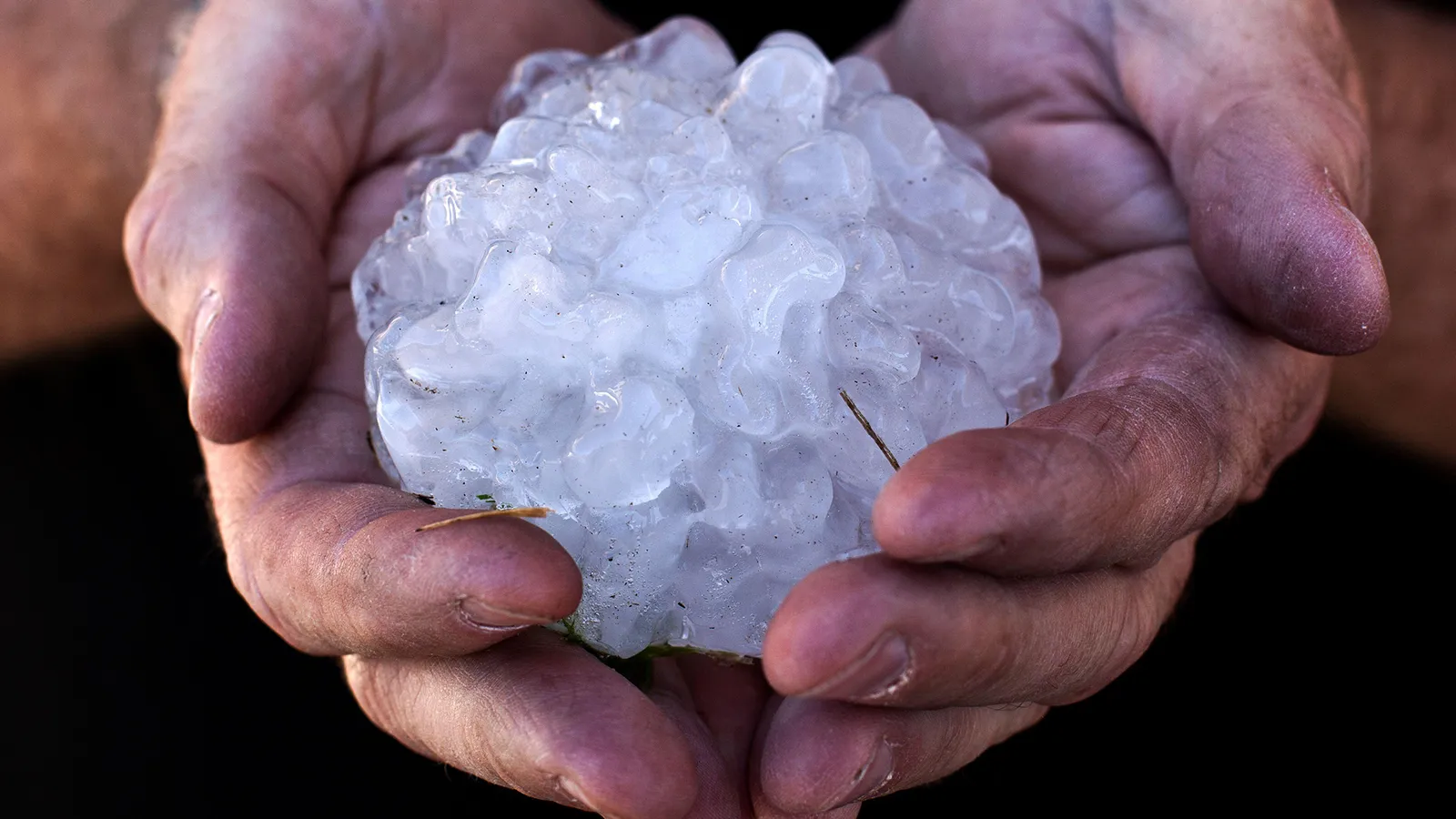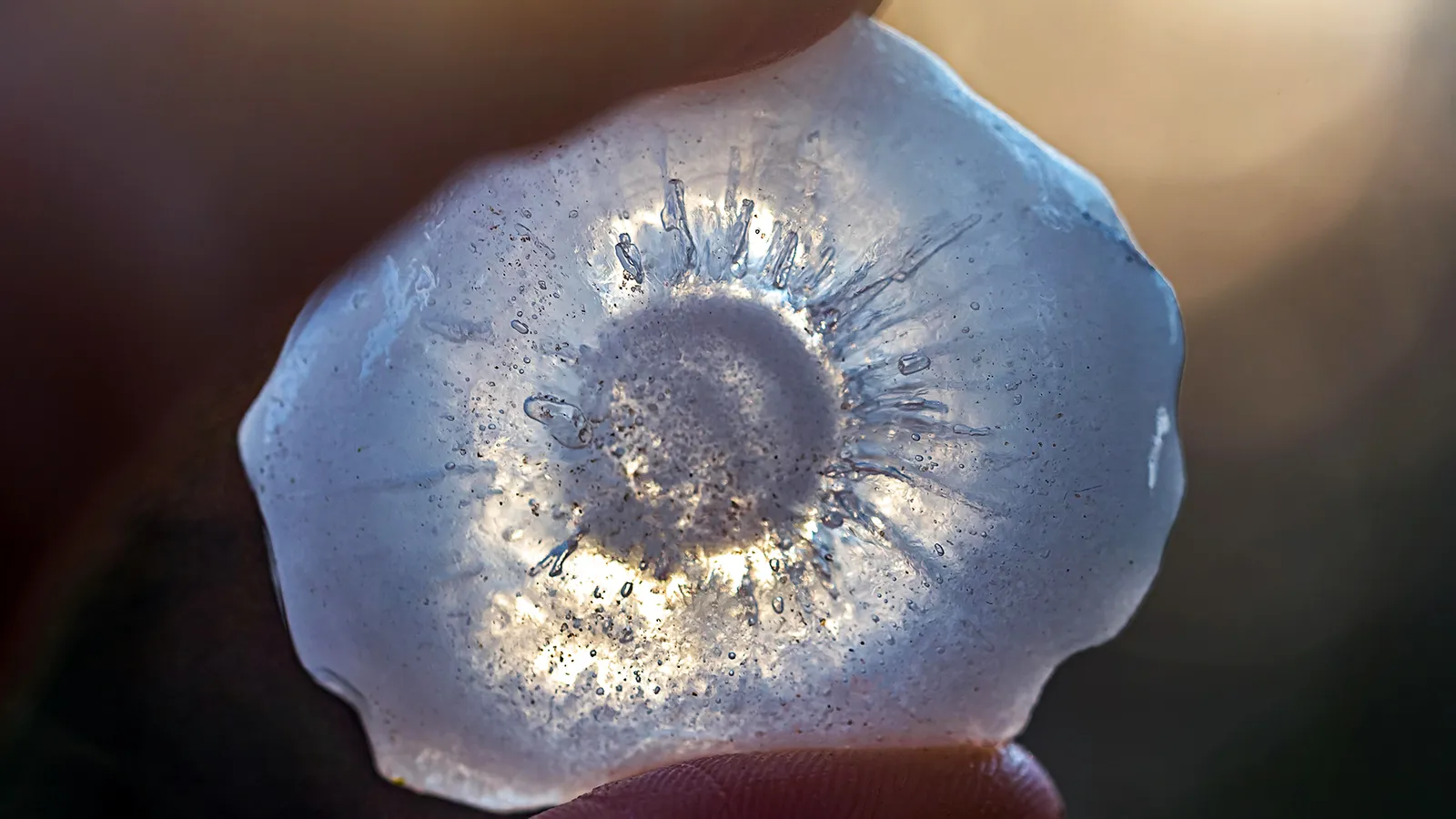Giant hail squids that fall in the summer and cause heavy losses... Does climate change have anything to do with it?!
Arab Weather - On Tuesday, a severe cold storm hit the Catalonia region, northern Spain, after the unprecedented heat wave that the country witnessed. Some hailstones are up to 10 centimeters in diameter.
Why are hailstorms becoming a more frequent phenomenon, with hailstones of gigantic sizes?
David Hambling of BBC Future wrote an article published in March of this year, explaining why:
Although hailstorms typically occur during the summer in many parts of the world, it appears that climate change has begun to change the pattern of hailstorms. These are examples of severe hailstorms that have recently hit some areas:
- On the evening of July 21, 2021, hail the size of golf balls fell from the sky over Leicestershire, central England , smashing windows and cars. As for the gardens, which, moments before the hail, were crowded with people enjoying the sun before sunset, they were badly damaged by the torrential rain of hail.
- An even more intense storm hit Calgary, Canada , in June 2020, with hailstones the size of tennis balls causing damage to at least 70,000 homes and vehicles, destroying crops and causing $940 million in damage to the region. The hailstorm, which lasted for 20 minutes, was one of the most severe weather conditions that took the country's toll.
- In 2020, a hailstorm hit the Libyan capital, Tripoli , with beads about 18 cm in diameter.
- In the US states of Texas, Colorado and Alabama , hailstones have broken the record in the past three years, reaching 16 cm in diameter.

But why might global warming increase the amount of hail falling from the sky? Are there any limits to the size of hailstones?
How are hailstones formed?
A hail forms when water droplets billow upward during thunderstorms. The updraft carries them to parts of the atmosphere where the air is cold enough to freeze the droplets. Moisture in the air accumulates on the outside of the ice droplets as they move through the air, causing the hailstones to grow into layered balls like onions.

The speed of the growth of snowflakes depends on the amount of moisture in the air. It continues to grow until the rising air current weakens, and it is no longer able to keep it high in the atmosphere.
For more: What is cold and why does it sometimes fall in summer?
An air current rising at 103 km per hour can carry snowballs the size of a golf ball, while a 27% faster current can carry pieces the size of a baseball, according to the US National Oceanic and Atmospheric Administration (although we'll see shortly that the size of these pieces is not It is always directly related to its weight).
Air with higher humidity and stronger updrafts bring in larger chunks. Large pieces usually fall close to the updraft while smaller hailstones fall away from it, often being blown there by crosswinds.

What stimulates the growth of hailstones?
“Destructive storms that produce hailstones larger than 25 mm in diameter require a specific set of conditions,” says Julian Primelo, a physical sciences specialist with the Canadian government’s Environment and Climate Change Administration, who has studied how climate change affects snow formation. :
- sufficient moisture.
- Strong rising air currents.
- A "stimulating" factor, usually an air front.
This is why dangerous hailstorms are usually confined to certain areas such as the Great Plains in the United States and the Gold Coast in Australia.
The air in these areas is usually cool, dry in the upper atmosphere above the warm, moist air at the surface. This unstable situation leads to strong updrafts and thunderstorms.
These locations are particularly vulnerable to a type of thunderstorm known as "Super Cells", which can produce very large shards of ice due to the intensity of the swirling updrafts they produce.

What is the role of climate change in this process?
Because climate change changes the temperature of the Earth's atmosphere, so does the amount of moisture in the air, and warmer air may contain more water vapor, while higher temperatures also mean more water evaporates from the Earth's surface.
This is expected to lead to heavy rains and more severe storms in some parts of the world, in an attempt by the Earth to restore thermal balance.
“As the planet continues to warm, the areas that are most likely to experience blizzards are likely to change, so that areas where lack of sufficient moisture is a limiting factor at the moment will become wetter later on,” Primelo says. The frequency of hailstorms may increase.”
A combination of monitoring climate changes that are already occurring and modeling the expected changes led the researchers to conclude that ice storms will become more frequent in Australia and Europe, but that there will be a decline in East Asia and North America.
Cold storms may become more severe in general
Although these storms may become less frequent in North America, hail will likely increase in size as they fall, according to a separate study by Primello and colleagues focused on how conditions in North America will change in a warmer world.
One reason for this is that the altitude at which the chunks begin to melt as they fall will increase, so the smaller chunks will melt and turn into rain before they reach the ground, but the larger chunks will pass so quickly through the warm region that melting won't have much effect on them.
“We have already seen evidence of this, with ice sheet data in France indicating a shift in its size distribution,” says Primillo.
Ice sheets are lumps of smooth ores left in storms and deformed when they hit the ice, and give an idea of the size and number of snowflakes in the area.
This may mean that annual damage from ice may also increase. But it is difficult to say which areas will see an increase, according to Primelo.
The density of cold grains
The temperature and humidity of the air in which hailstones form can affect their density.
In very cold air, the water freezes as soon as it hits the hail, but this can lead to a lot of air and ice mixing. If water freezes more slowly, perhaps because the air is warmer or because the amount of moisture in the air is high, which means it doesn't completely freeze right away, the air bubbles have time to escape.

This results in clear ice that tends to be denser. Small hailstones are half the density of clear ice, and there is a lot of air in them because they tend to move quickly through the atmosphere before falling again.
The largest hailstones often consist of a complex mixture of layers of ice that form as they move through the air column.
Looking at a cross-section of the ice can reveal a great deal of how it formed, while the ice-like structures on the outside of a hailstone also provide clues to how it circulates in a storm.
hail size
The density of a hailstone also affects how much it grows, the heavier it is, the more likely it is that it will fall from the rising current. It will also fall faster, because the larger the hailstone, the less drag it will have per unit weight.
The heaviest hailstone that ever fell was recorded in the Gopalganj district of Bangladesh in 1986, and it weighed 1.02 kg.
The hail storm killed 40 people and injured 400 others, according to media reports at the time, but later reports indicated the death of about 92 people.
How large can hailstones grow?
Meteorologists believe that climatic conditions are already in place to produce much greater hail than those recorded so far
Meteorologist Matthew Kumjian of Pennsylvania State University estimates that the largest hailstone could be 27 centimeters in diameter, larger than a football, based on simulated weather data.
However, nothing this large has yet been recorded, and he says he is working with some colleagues to improve the accuracy of the estimates. While 27 cm is the upper end of the estimates, hail pieces in these proportions would be highly irregular in shape.
But he says the ingredients needed to make such a large hailstone — strong updrafts, lots of super-cooled liquid water, and a long time of movement in the cold air — are in place right now.
"Powerful thunderstorms that produce the world's largest hail contain many of these components together, so perhaps the most powerful of these storms today can produce giant hail."
Arabia Weather App
Download the app to receive weather notifications and more..



